When embarking on an improvement journey, organisations too often give into temptation and jump directly to process improvement, either by designing a new, optimised, Lean process, or attempting to immediately create a digitised, automated version of their existing manual process.
While this approach of skipping ahead to your desired future state may seem like the best way to fast-track your improvement journey, more often than not it will result in the delivery of solutions that either miss the mark entirely or even exponentially increase your existing process problems.
“The first rule of any technology used in a business is that automation applied to an efficient operation will magnify the efficiency. The second is that automation applied to an inefficient operation will magnify the inefficiency.”- Bill Gates
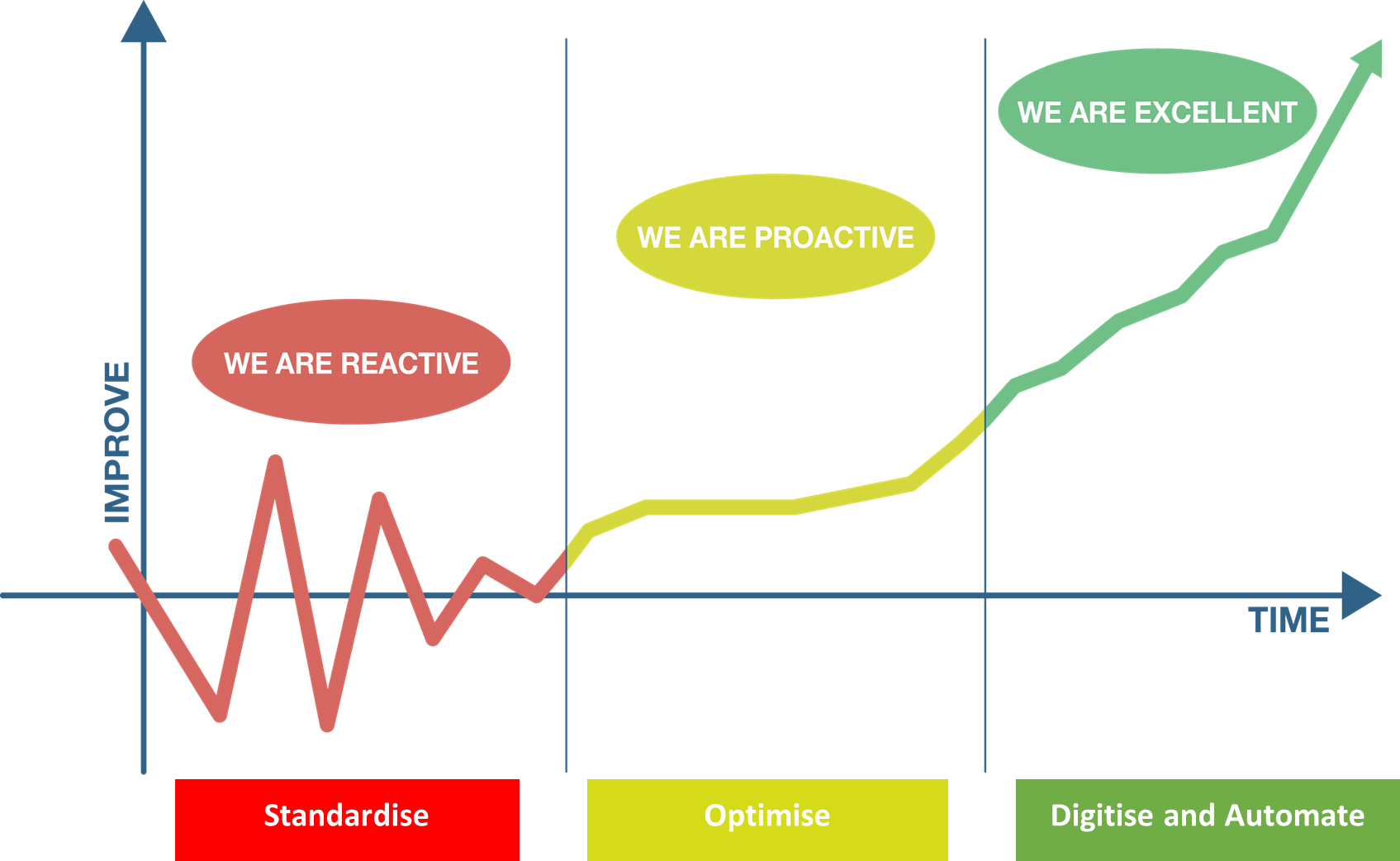
Using the SA Partners Improvement Journey pictured above, if you find yourself in the ‘Reactive’ phase, you are likely to be experiencing:
- Inconsistency in the way that work is performed, depending on who is doing the work and/ or when the work is being done
- Inconsistency in the outputs that are produced by your processes, resulting in a highly variable customer experience
- Significant management time spent responding to and resolving problems
- High rates of turnover with employees feeling like they are unable to achieve their assigned KPIs, and having no internal growth and learning opportunities
At this stage of your improvement journey, your focus should not be on improvement itself, but rather on achieving a state of stability where work is done in a standardised way regardless of when, where, or by whom the work is performed.
Achieving this level of standardisation will not only ensure that your processes produce consistent outputs, but will also lay the foundations for you to do proper root-cause analysis of process problems, and therefore ensure that future optimisation and automation projects deliver meaningful results.
The question then becomes, how can we get out of the red ‘squiggly’ line and achieve stability?
- Identify your processes
Step one is to simply identify your processes. Another common mistake I see organisations make is to jump straight into talking about the details of how their processes operate without giving enough consideration to what their processes are to begin with. An example here might be a sales team talking through their processes starting with how they qualify leads provided to them by marketing. Separately the marketing team may discuss their process ending with how they qualify leads before passing them over to sales. All of a sudden leads are qualified twice which is not only waste but also a cause of frustration to your prospective clients.
Before getting into the details then, you should run a scoping exercise where you identify your process groups, the boundaries of these process groups, and finally the processes inside these groups along with their boundaries. If we consider a process hierarchy, at this stage we are trying to define levels zero, one and two.
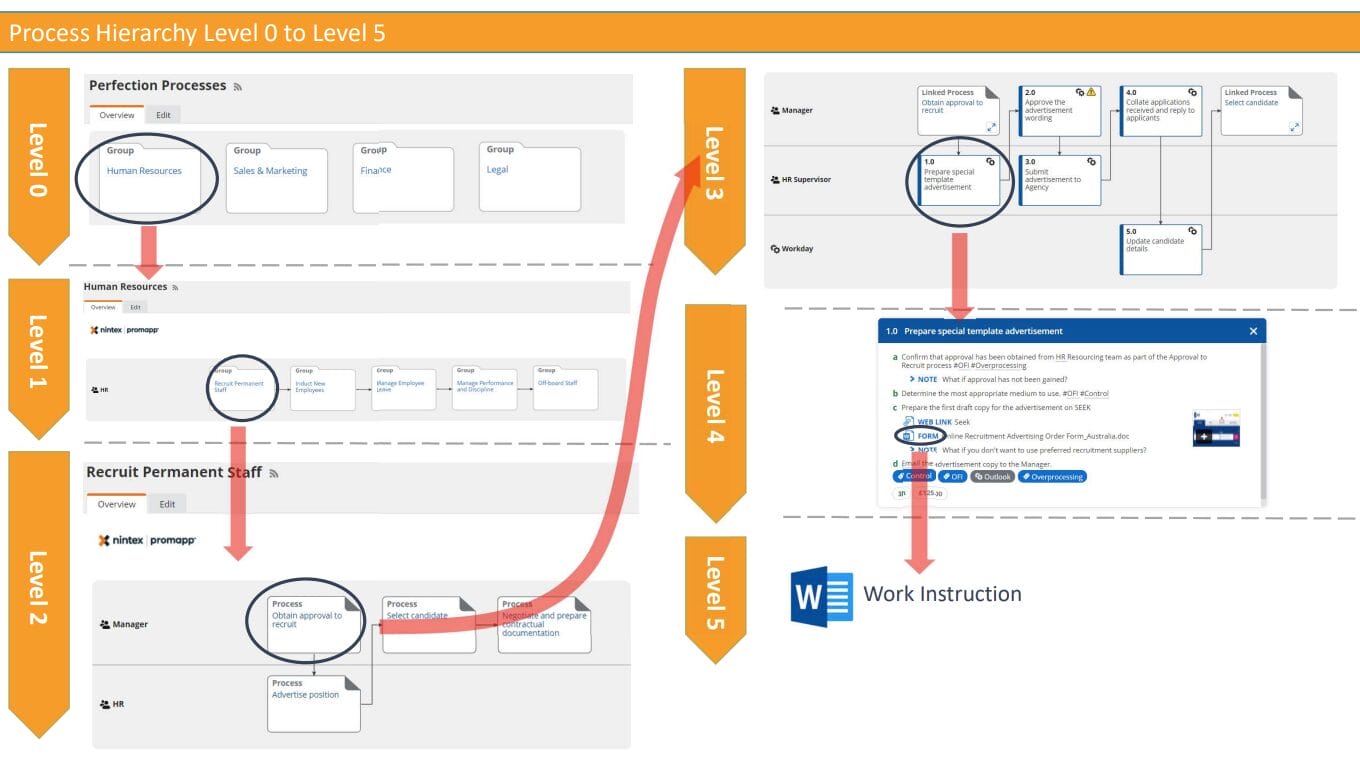
2. Capture your As-Is processes
Now that we know what our processes are, we are ready to capture the As-Is (levels three, four, and five). The process capture sessions shouldn’t be performed by a process owner in isolation, rather a workshop should be held with a collection of SMEs so that what is captured represents what takes place in the real world, not what the manager thinks takes place. Determining who should attend this workshop is a critical decision, on the one hand, you don’t want to get into a position where you are stuck because no one in the room knows what happens next, but at the same time if you invite every man and his dog you’re going to go round and round in circles trying to come to an agreement. The approach that I take is inventing the absolute minimum number of people that will allow us to get something done and out the door.
When running these workshops there should be a number of ‘house rules’ – the following are the rules that I like to enforce:
- Spelling doesn’t matter
- All must contribute & be present
- No hierarchy + Vegas rules
- Start with the As-Is
- Stay on topic and use the parking lot
- Progress, not perfection. ELMO! (Enough, let’s move on)
During these capture sessions, it’s easy to get caught in the weeds and go round and round in circles trying to agree on exactly how a process is exactly performed or chasing each other down rabbit holes. When facilitating these workshops I always focus on getting things done and set the bar as ‘Can we all live with this’ rather than ‘Is this right?’ with an understanding that we are just mapping version 1, which will be iterated over time.
Consideration should also be given to how you run these workshops and a consistent approach should be taken (i.e., every workshop should be run in the same way every time using the same templates). I prefer Miro, where I’ve developed the following capture template:
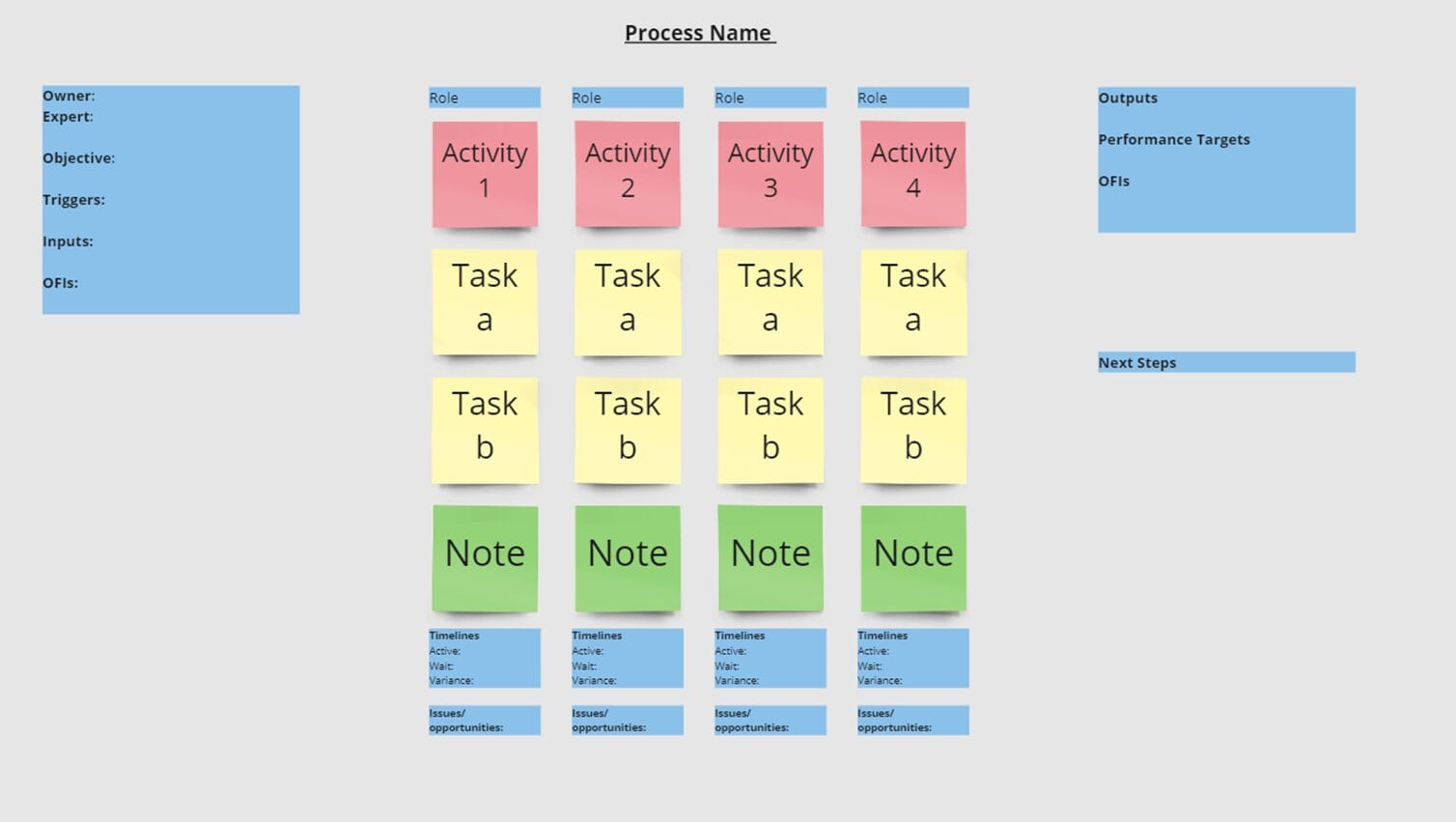
I find that this template allows me to capture all the information that’s needed, and do so in a way where I can keep the group focused.
Importantly, during this workshop process ownership needs to be assigned. Who is going to be the Process Owner? Who is going to be the Process Expert? It will be these two people that will be responsible for making sure that the documented process becomes the lived process, as well as maintaining and updating the process moving forward. This decision is often the difference between process management being a theoretical exercise and getting us out of the red squiggly line.
3. Map and Share your As-Is Process
Whatever tool you decide to use for your process capture workshop is simply that, a tool for the process capture workshop. You need to quickly take the output of these workshops and document your processes in a proper process management solution.
SA Partners have been involved in Process Management projects since our inception 30 years ago, and over that time we’ve used almost every major process mapping tool in the market. After extensive research and experience, we’ve identified Nintex’s Process Management tool as our tool of choice, and is what we recommend to our clients.
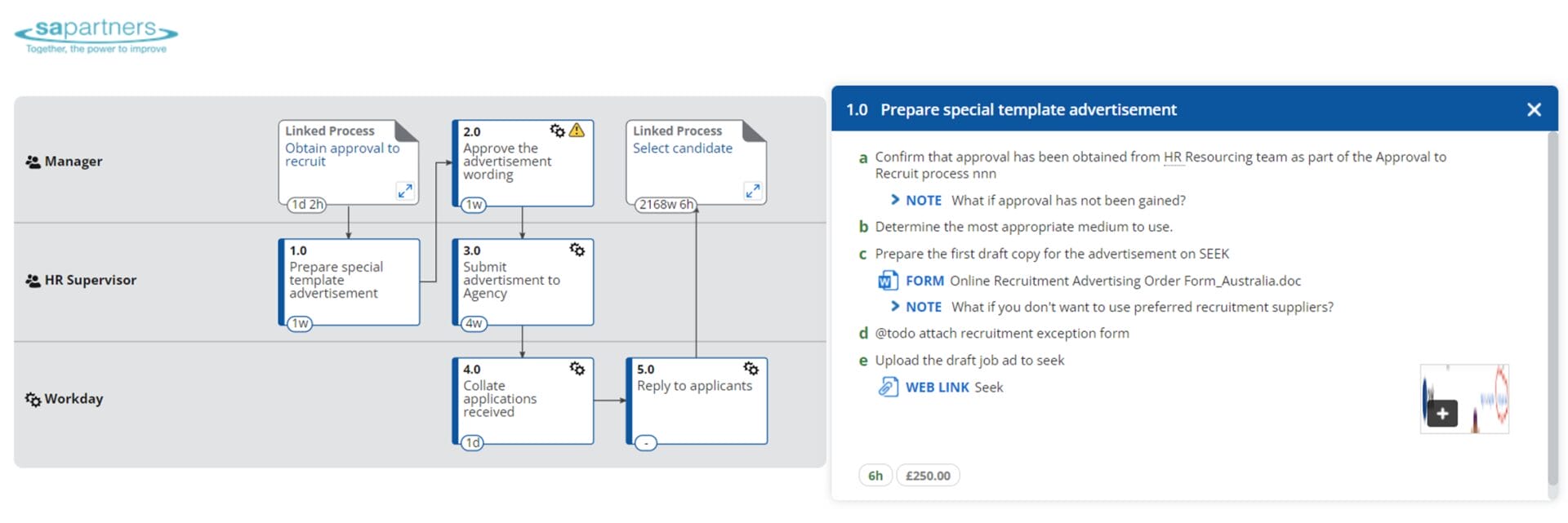
Once your process has been documented in your process management solution, it should be shared with the workshop attendees and other key SMEs. This is something that I like to be timebound, I will say ‘here is a link to the process that we captured during our workshop, please review and leave any feedback by next Friday (March 24th) at which point I will submit it for approval’. This approach allows everyone to have a say without slowing us down if people get lazy.
This process is made very easy with Nintex Process Manager where a shareable link can be created allowing SMEs to interact with the process and leave feedback if needed (have a go yourself here).
4. Approve and Publish your Process
Once the relevant SMEs have provided their feedback (or have not raised any objections) it’s time to get the process out the door. While this stage might seem obvious, I find clients often struggle. Once they have captured something they want to hold onto the process and keep polishing it until it’s perfect before they release it. The problem is that the only way that you will achieve standardisation is if your process participants are actually given the process that you want them to follow; as such my recommendation is to get the process published ASAP.
There should, of course, be checks and balances, again if you use Nintex Process Manager this is all automated where the required process approvers will have to formally approve the new or changed process (all captured in the change log) and then have it published by an administrator.
5. Standardise and Stabalise
All we’ve done so far is come to an agreement on the current state process which we now need to operationalise. This starts with letting our process participants know that there is a new or changed process that’s relevant to them. Again Nintex Process Manager will automate this by issuing notifications to all relevant stakeholders:

If it is an existing process that is changed, we also need to make sure that process stakeholders are crystal clear on what specifically has changed. In the example below, by comparing the new version with the previously published version, I can see that the Manager no longer needs to reply to the applicant as this is now automated by the Workday system:
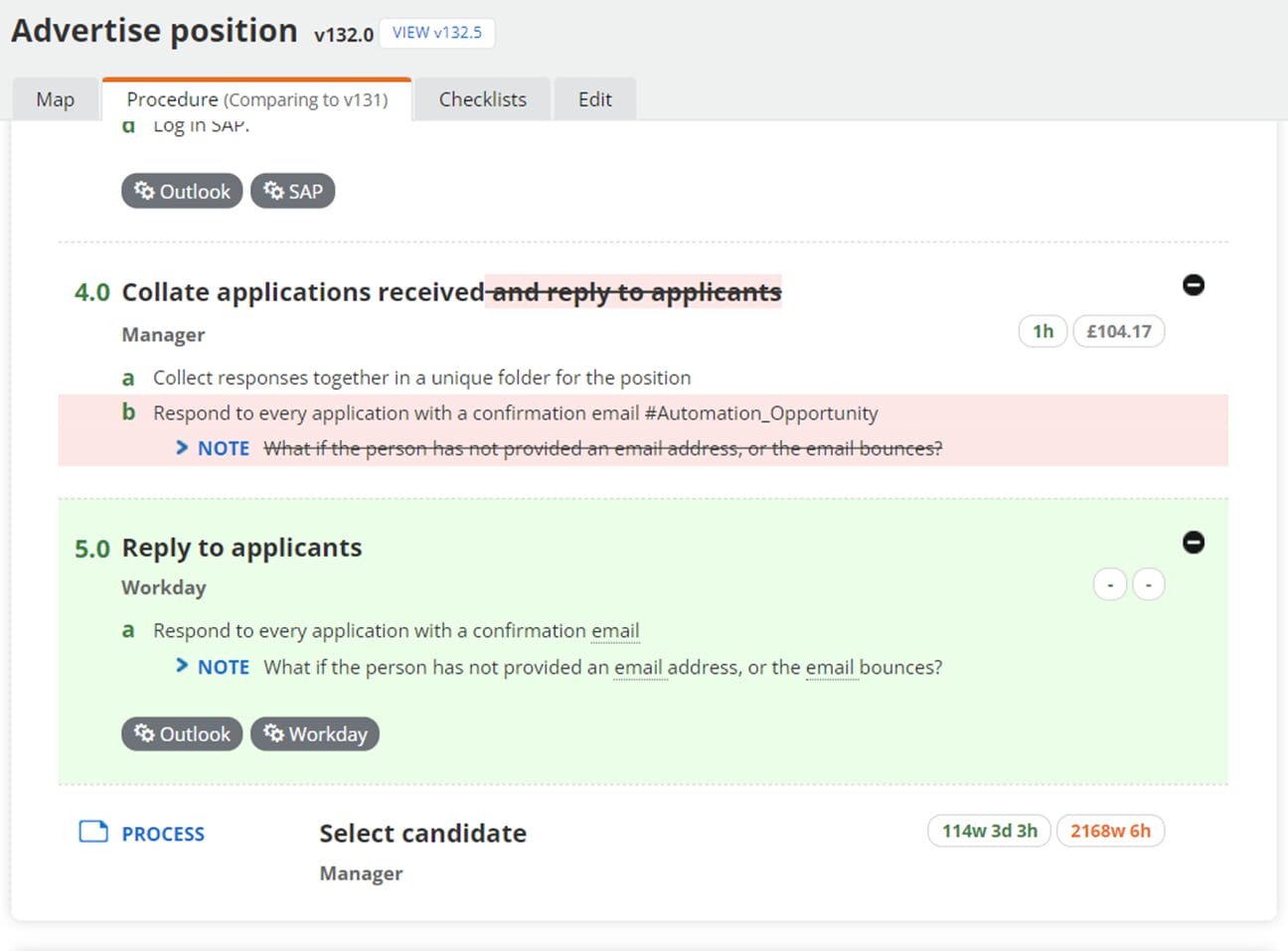
Once our SMEs know that a change has taken place, and what specifically has changed, they should acknowledge the change to commit to changing the way that they work:

6. Monitor and Enforce
Shortly after a new or changed process is published (appx two weeks) process owners should review reports to see who has/ has not acknowledged the change, and for those who have not, reach out to them to make sure that it gets done and they are fully committed to performing the process as it has been documented.
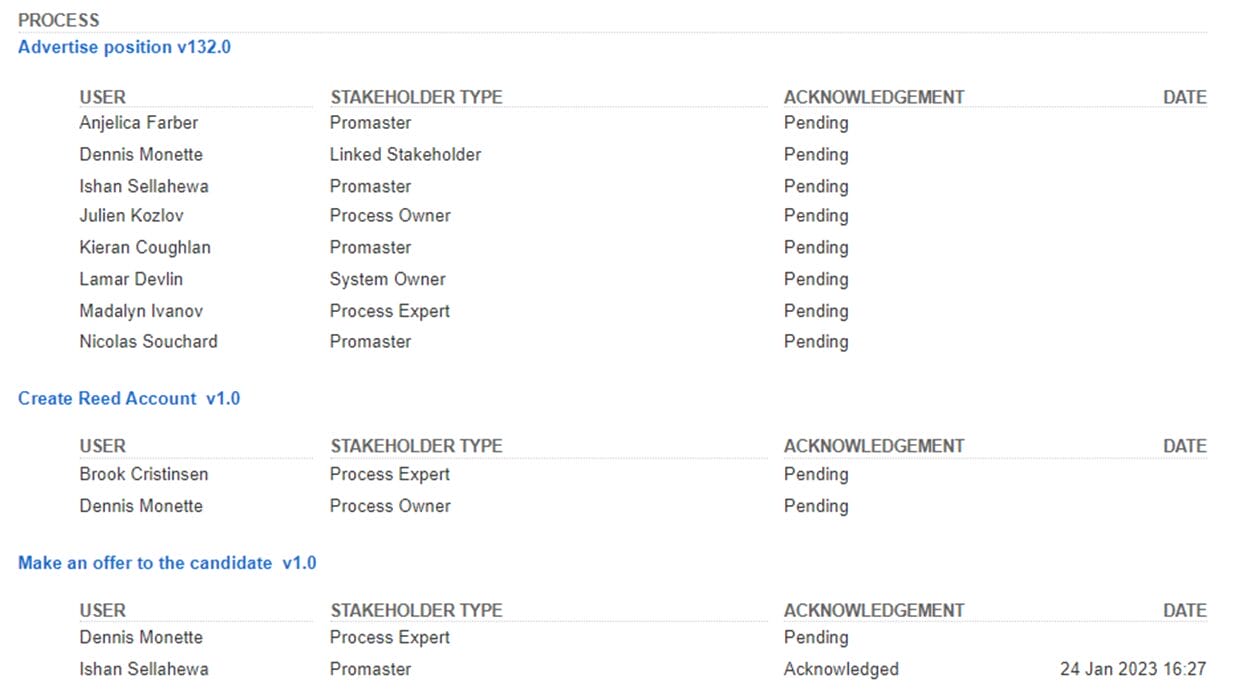
It is also the responsibility of process owners and experts to monitor what is happening in the real world and ensure that the lived process is the documented process. Where there is a discrepancy it’s up to them to bring alignment which may involve using change management to bring process participants to the documented process, or updating and iterating the documented process so that it aligns with what is happening in the real world (prior to considering any desired future state).
My key message here is to not ignore the importance of standardisation and stabilisation. Not only will this provide the platform to make a meaningful improvement in the future, just the simple act of achieving standardisation and stability will deliver substantial benefits in and of itself.
Digital Transformation Business Manager

